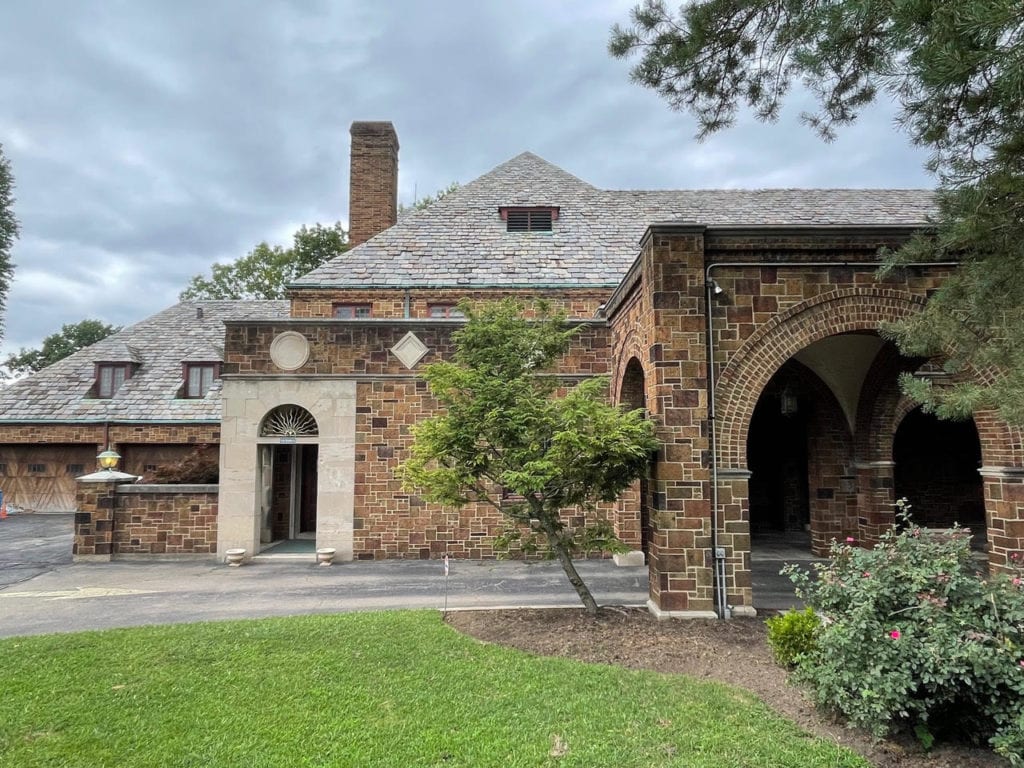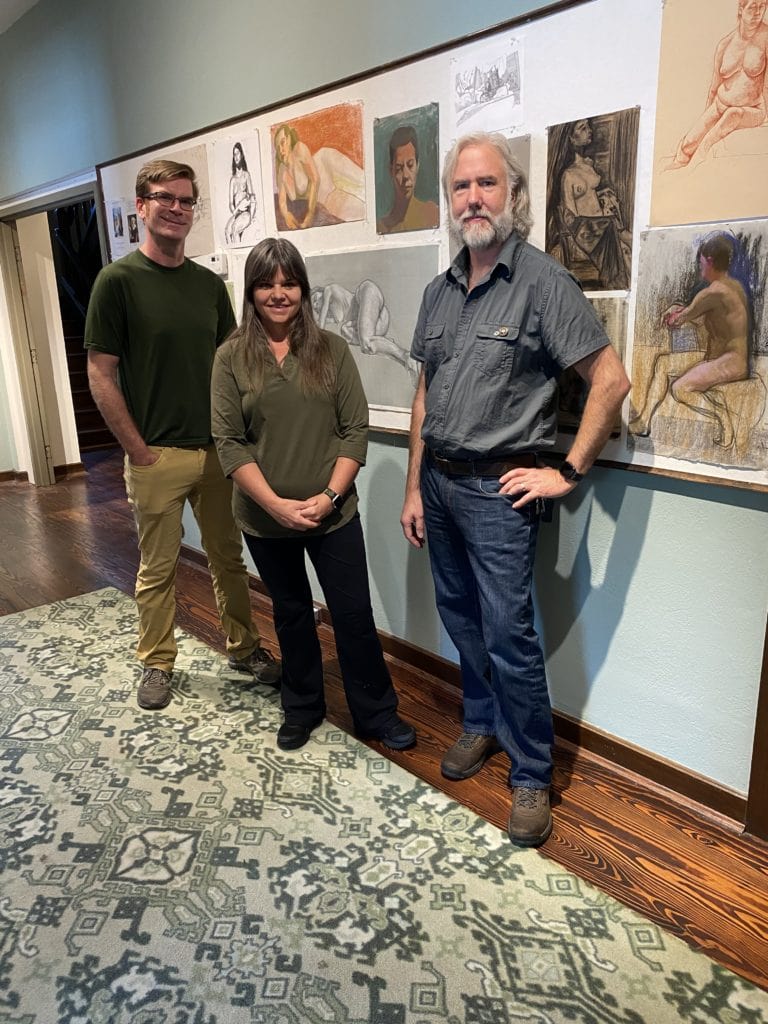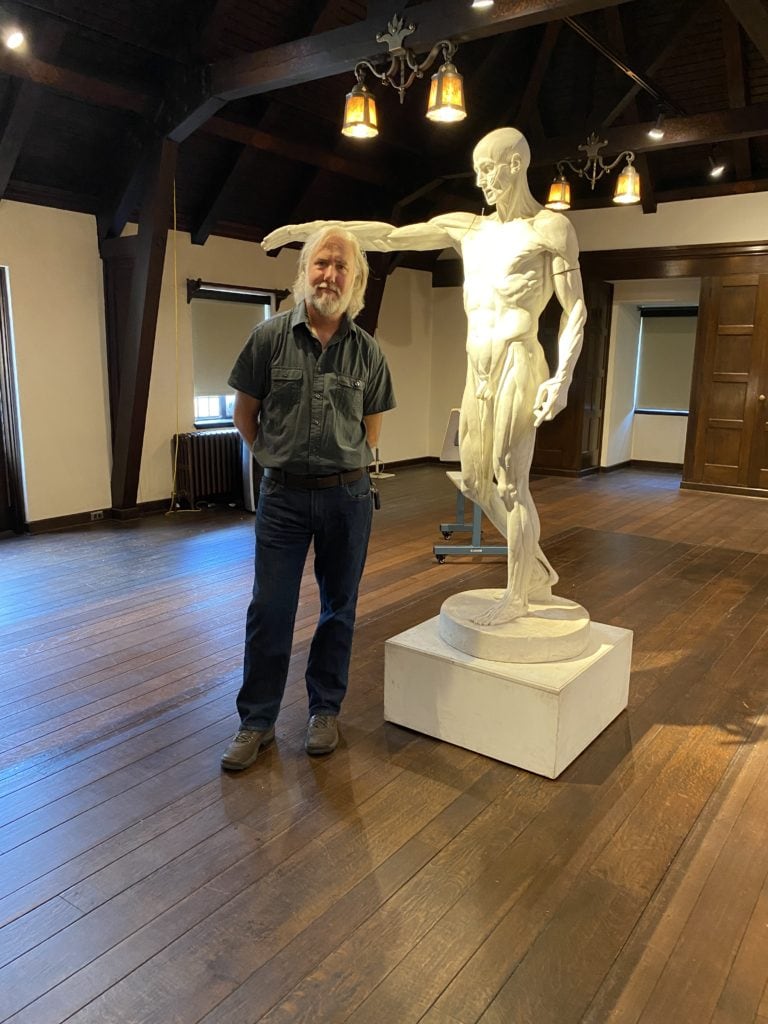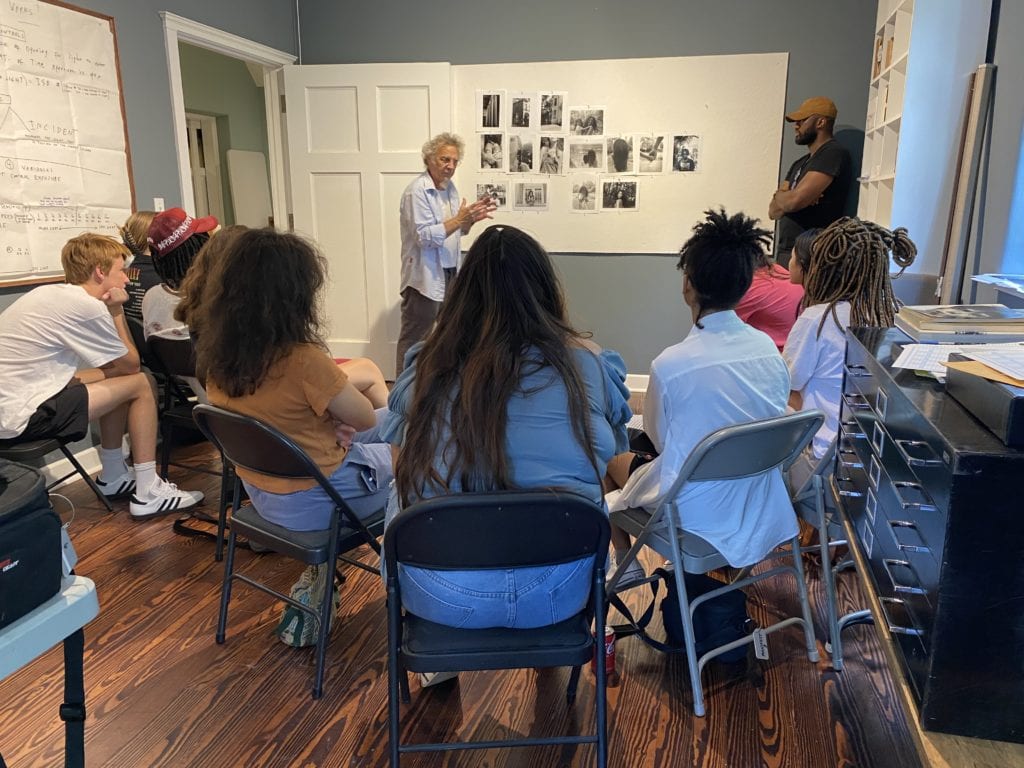Currently Manifest Creative Research Gallery and Drawing Center is split between two locations, one on Central Parkway and another at 2727 Woodburn Avenue in East Walnut Hills. The new Central Parkway location is in a building constructed in 1932 in French Normandy style. Formerly Busse and Borgmann, a prominent funeral home, the building is approximately 18,000 square-feet with 16,000 of it usable. It is on one acre in Clifton near Cincinnati State and DePaul Cristo Rey High School.

Goals for the building, according to Franz, are “first, to give Manifest the permanent home it needs to take a longer, stronger approach to its programming and impact on the visual arts for the region and beyond. This will establish sustainability for the operation of our organization.”
‘”Next to allow for the fusion of our two halves, the studio program and the gallery program under one roof,” Franz said. “This will not only allow us to serve the participants in both much more fully, but it will make Manifest more meaningful as an experience for the wider community. “

“We have an agreement with the building, which is itself a work of art. We will save it, and it will save Manifest,” Franz said. He envisions the center as a regional institution that has a promising future for several decades. Currently, the building houses the Drawing Center with offerings in drawing, painting, darkroom photography, a future printmaking studio, and a scholar in residence studio.
Franz said he was happy to acquire a historic building for Manifest’s permanent home and the future headquarters of Manifest’s multiple programs.
“M1”, a nickname that the new center is sometimes referred to, stands for mastery and magic focusing on the visual arts. Franz said, “It can also stand for Manifest-one, the future single or primary location of all of Manifest, or M1 as our future world headquarters. It is intended to be a sanctuary for the practice, learning and experience of the visual arts.”
Walking into the building through the front doors transports a visitor to another time and space. There are two wooden hand-carved gates, a large lobby, an entry way to a significant structure on a busy thoroughfare. A reception office and bookstore will also be in the front area of the building.
There are four profiles of different people carved on each side of each gate. Athough Franz said, “We do not know who they represent, but I like to think they represent the four quadrants of Manifest: its Gallery exhibitions, Drawing Center studio programming, the publications of Manifest Press, and our artist residency.”
Franz described the building layout. Floor one has roughly 8,000 square feet, including the future printmaking studio. Floor two has roughly 6,000 square feet. The basement and attic will be storage, utility, and support spaces. The office space falls slightly between floor one and floor two, and will be used for administrative/staff offices and a conference room.

On-site parking for approximately 25 vehicles is available, as well as on street parking. More parking at nearby institutions has been discussed for potential collaborative options, along with valet parking for Manifest’s popular gallery openings and other larger events.
Franz said it wasn’t easy to find a building of this stature. The board and staff looked at buildings for several years in blighted conditions, in unsafe areas and with little or no parking. They considered cost, location, and condition. Eventually, they lucked out.
Debbie Heuer, president of the board at the time, found the Central Parkway structure online. “There was a skip in Jason’s step,” said Brigid O’Kane, Manifest co-founder and Jason’s wife, “when the staff and board saw the building for the first time.”
Janelle Kelpe, a local architect with her own firm Chroma Architecture + Design, has volunteered time to create early concept plans, advice, and analysis for the building. Currently on the Manifest facilities committee, she will present a contract proposal to the board as an official project architect by November 2022, although other architects’ proposals may be considered. The goal is to have the building completely renovated by the end of 2024.
Manifest staff worked with City officials to rezone the building as a cultural institution and received the appropriate city permits. The city asked for basic updates such as fire doors to enclose the stairway, egress lighting, and exit signs. This was done, but some of the changes may be temporary as the design of the building will evolve through renovation.
A secondary egress is under consideration for the final renovation. Franz said, “The foregone conclusion is there will be a new exit from the large upstairs studio into a stairwell that will descend through and into an existing utility space at the end of the arcade and exit at ground level. This same exit stair will also be available from the future east-side rooftop deck, and all the (future) green roofs along that side of the building.”
A significant Small Business Administration loan received in 2021 helped maintain operations, make capital improvements and provide for the first phase of occupancy until Manifest can raise additional money. Recently, Franz said a donor, who chose to remain anonymous, and whose children have attended Manifest studio programs, donated $70,000.
Mysock said Manifest represents Cincinnati values, and reflects Cincinnati’s simultaneous love for history and creative innovation. It serves as a traditional steward of art history, but also reaches to the future. The Gallery is not commercial, it engages with artists of all levels, but at a high level of quality, and connects them to Cincinnati from around the world.
Anna Kipervaser and Hanna Sosin are the current 2022-2023 artists in residence. Isaiah Armstrong is the current 2022-2023 scholar in residence.
Franz said the gallery on Woodburn Avenue brings in work by, on average, over 250 artists in a year. He points to Manifest’s accomplishments as of its full 18th season stating that, since Manifest was launched in January 2005, 3,874 artists have had work included in Manifest Exhibitions and Publications. There have been 423 exhibits, 35 books, 74 catalogs, and 224 academic institutions represented by student artwork.
Since the Drawing Center program currently fully occupies the Central Parkway facility, Manifest’s Education and Studio Program Manager, Adam Mysock, oversees the new building. The organization is run by a non-profit board with Franz as executive director. O’Kane, Associate Professor in the School of Design at the College of Design, Architecture, Art and Planning, University of Cincinnati, is co-founder and also member of the board. She also teaches the popular weekly Drawing as Mindfulness course for Manifest.
Originally a teacher at Tulane University in New Orleans in 2008, Mysock decided to move back to Cincinnati after his first child was born. He applied for the Manifest residency program and it became his studio in 2016-2017. When his current position opened up, he was offered the job of coordinating Manifest’s Drawing Center programs, and accepted.
By 2025 Mysock wants the studio program at Manifest to be open seven days a week, twelve hours a day and expand people’s engagement, offer a supportive environment for students and provide a stabilizing influence in the art education ecosystem.
Founded in 2004 by Franz, O’Kane and Elizabeth Kaufmann, one of Franz’s students, the Center started in East Walnut Hills on Woodburn Avenue at a time when the area was blighted. As a result, the very low-cost lease was locked in for twenty years. The trio, along with several other students of Franz’s, looked at a number of places, such as in Evanston, Norwood, and the West Side. “We got the Woodburn space at a minimal price,” Franz said, “That made this all possible.”
The Gallery’s lease will be up for renewal in 2024 at which time Franz and his team will consider what will be, if the vastly expanded market is any indication, a dramatic price increase. But Franz’s dream is to keep the East Walnut Hills space as a smaller footprint for special gallery projects, solo shows, and expanded bandwidth for the primary galleries that will be in the Central Parkway facility.
The Drawing Center studios relocated six times including a stint in Madisonville from 2011 – 2019. When it came time to renew that lease the rent was increased 500%, so the Center moved to The Eddy, 656 East McMillan St. in Walnut Hills in 2020 right when Covid-19 was striking.
Manifest is a 501(C) (3) nonprofit organization. Galleries are free and open to the public Tuesdays through Fridays, 12-7 p.m. and Saturdays 12-5 p.m. Franz said, “We have maintained since our inception in January 2005 a five days per week schedule for every exhibit every year, week in and week out.” To help with this schedule, there are two full-time staff and two part-time staff, as well as routine co-op students from the School of Art at the University of Cincinnati and other regional and sometimes national colleges. In all, Manifest has six permanent staff, two of which are full time. These are split between Gallery and Drawing Center programs.
Franz said, “Manifest will remain ‘a neighborhood gallery for the world’,” as he talks proudly about Manifest’s new home in Clifton at the edge of Camp Washington, and within sight of Northside.
Many of Manifest’s exhibitors, and some of its students, go on to become professors of art or design. The network expands. “It’s magical to see it happen,” Franz said. There are already multiple generations of student/teacher relationships that have connected through and into Manifest.

In anticipation of their 2024 goal, Manifest is considering a capital campaign to raise money and renovate the building. It will keep the outside traditional structure, but will inevitably update the interior to serve the contemporary programming is it known for. In the end the building will be a carefully crafted mix of the new and old. Still in the discussion phase, a campaign would also help significantly expand programming, staffing, and help maintain the new building and its grounds.
Manifest has received money from the American Rescue Plan, ArtsWave and an out-of-state donor who paid for the down payment on the building which cost $680,000. Northside Bank and Trust provided a mortgage of $540,000.
Franz said, “The act of bringing Manifest’s two halves together at M1 will be like creating a fusion reactor that will generate positive clean and creative energy by establishing a sanctuary for the practice, learning, and experience of the visual arts.” He wants to pay competitive wages, help artists make a living, have artists feel energized, and to invest in what we have given to Cincinnati over the past 20 years. Manifest has put $2 million in working artists’ hands with awards, teaching salaries, artist employment, and art sales through gallery exhibits.”
Franz added, “Manifest was founded to take a stand for the importance of quality in visual arts–in the work itself, in its presentation, and in the teaching and learning it needs in our society.“
“As our mission statement explains: It stands for quality in the visual arts, as well as the importance of creative research, meaningful and accessible art-based experiences for the public, deep learning outside academia, and the rigorous documentation of exceptional art for posterity. The organization seeks to engage students, professionals, and the public from around the world through accessible world-class exhibits, studio programs, and publications centered on the broader visual arts,” concluded Franz.